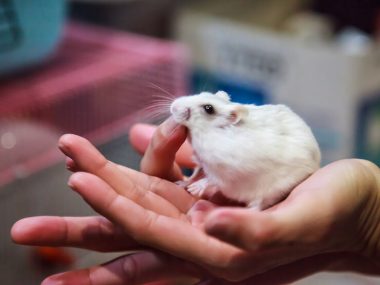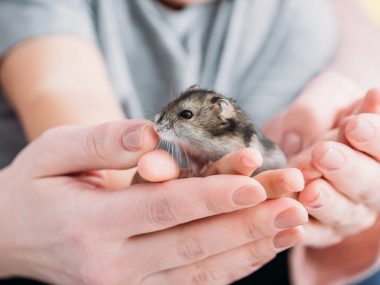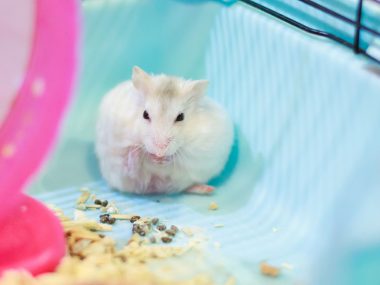The flea fan base amongst humans is sadly lacking; unlike Miriam Rothschild, a famous entomologist who discovered how fleas jump, most people are horrified at the thought of blood-sucking fleas! Just thinking about fleas can make you feel itchy, but what about your hamster? Can hamsters play unwilling host to fleas, or are they somehow immune?
Any breed of hamster can get fleas. Flea infestations in pet hamsters are less common than mite infestations. Effective hamster flea treatment includes Selamectin, Fipronil, Diatomaceous Earth, using a flea comb to remove adult fleas, good cage hygiene, and treating other household pets for fleas.
Flea infestations are the bane of every pet owner’s life. Many hamsters are kept in multi-pet households, and owners become concerned about their hamster’s health if the family dog, cat, or bird gets infected with fleas. Can the fleas pass from the other pets to your hamster? And what are you supposed to do if you find fleas on your hamsters?
Table of Contents
Can A Hamster Get Fleas?
The role of rodents and fleas in the spread of the bubonic plague has created a knee-jerk assumption that all rodents carry a heavy flea burden. However, it is not just rodents who can play host to fleas; fleas can infest almost any type of warm-blooded animal, including dogs, cats, birds, and … you guessed it, hamsters!
Because hamsters are rodents and look vaguely mouse-like many people believe that hamsters are more vulnerable to flea infestations than other household pets. This belief is not true!
A healthy pet hamster kept in a clean cage is no more likely to get fleas than your dog or cat. Hamsters in hamster-only households are less likely to get fleas than hamsters living in multi-pet homes!
Can Dwarf Hamsters Get Fleas?
There are no breed-specific hamster flea species, i.e., all hamsters can get fleas regardless of their breed. For example, Nosopsyllus fasciatus, a type of flea found on hamsters, are just as likely to infest Dwarf hamsters as Syrian or Siberian hamsters.
How Do I Know If My Hamster Has Fleas?
It is not always easy to spot the signs of fleas, especially if you are a first-time hamster owner or the flea infestation is mild. Most owners only notice the symptoms of a flea infestation after the hamster’s flea population has reached the double digits, e.g., ten or more fleas.
According to PetMD, the most common signs of a flea infestation in hamsters include:
- Abnormal scratching and chewing
- Alopecia, i.e, hair loss
- Red, irritated skin
- Small red bumps on the skin, particularly on the belly, armpits, and groin
- Pale gums
- Intermittent head tilt and shaking
- Flea dirt
- Seeing the adult flea
Flea bites cause localized skin irritation characterized by inflammation and itchiness. The itchiness causes the hamster to bite, scratch, lick and chew itself; this behavior exacerbates its hair loss and further irritates its already inflamed skin.
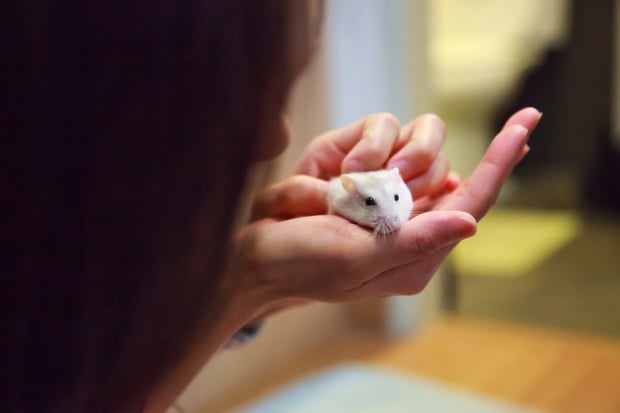
The aggressive scratching of frantic, flea-infested hamsters often causes severe skin damage, e.g., open wounds which become infected.
Fleas that crawl into the hamster’s ears will cause your hamster to shake their head and walk with a head tilt. The head tilt and head-shaking will continue until the flea leaves the hamster’s ear.
Another sign of hamster fleas is flea dirt. Flea dirt (i.e., flea feces) is small dark brown-black spots that look like dirt. Flea dirt is easiest to see on light-colored hamsters and virtually impossible on dark hamsters, e.g., black bear hamsters.
The last sign that irrefutably proves a hamster has fleas is being able to visually identify the presence of an adult flea on your hamster.
Can You See Hamster Fleas Without A Microscope?
Unlike flea eggs and larvae, adult fleas can be seen without the aid of a microscope. Without a microscope, you won’t be able to see the details of the flea’s anatomy, but you will be able to see the flea’s small brown-black body scurrying across your hamster’s skin.
Fleas are easiest to see in areas where the hair is thinner, e.g., armpits and groin, or areas with alopecia. If your hamster still has a thick coat of luxuriant fur, you may have to search for the fleas using a fine-tooth comb. It is easiest to spot fleas on hamsters with light-colored skin and fur.
The most common places to find adult fleas on hamsters are the following:
- Head
- Neck
- Ears
- Stomach
- Groin
- Armpits
How To Get Rid Of Hamster Fleas?
Effective hamster flea treatment includes a three-pronged approach:
- Get rid of fleas on your hamster.
- Thoroughly clean the cage and environment to prevent reinfestation.
- Treat other household pets for fleas.
How To Get Fleas Off My Hamster?
Getting rid of fleas on a hamster can be tricky; not only are hamsters tiny (i.e., higher risk of overdosing), but many of the modern anti-flea medications are toxic to hamsters. Selamectin, Fipronil, diatomaceous earth, and combing are the most popular methods for getting rid of hamster fleas.
Can Spot-On Treatment Be Used For Hamster Fleas?
Fipronil, an ectoparasiticide, is the active ingredient in Frontline spray and spot-on. A study conducted in 2000 found that Fipronil was safe to use on hamsters and effective against many of the flea species found on hamsters.
Selamectin is the active ingredient in the Revolution spot-on. Although Revolution is an anti-flea medication designed for dogs and cats, veterinarians and scientists have begun exploring the use of Selamectin in hamsters.
Hamsters are typically dosed at 16 – 18 mg/kg of body weight, i.e., 1 drop of 6% Selamectin solution applied between the hamster’s shoulder blades. Merck’s veterinary manual recommends a slightly lower dose of 15 mg/kg of body weight.
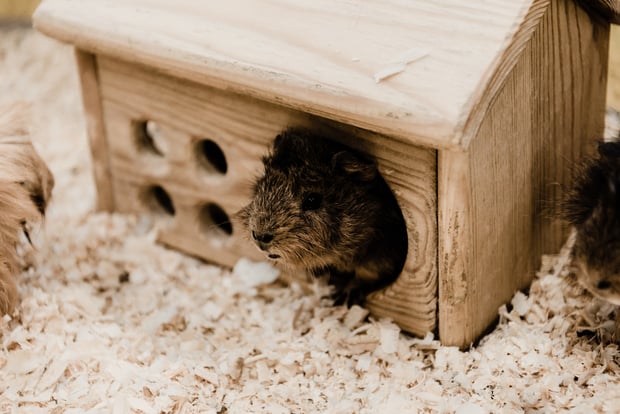
Selamectin can be used as a once-off treatment if the flea infestation is minimal or monthly if the flea infestation is severe.
Generally, spot-on anti-flea medication comes in a small plastic bottle containing a pre-measured dose for dogs or cats. Since hamsters are significantly smaller than cats and dogs, they will need a much smaller amount; you will need to break open the plastic bottle and, using a syringe, measure out the correct dose for your hamster.
Is Diatomaceous Earth Safe For Hamster Flea Treatment?
Many hamster owners and breeders have successfully used Diatomaceous Earth to treat fleas on their hamsters. Food-grade Diatomaceous Earth is non-toxic and safe to use with hamsters.
If you decide to use Diatomaceous Earth to treat your hamster’s flea problem, make sure to avoid creating dust clouds. Hamsters can accidentally inhale the sharp diatoms if they become airborne.
Use ¼ of a teaspoon of Diatomaceous Earth every second day until your hamster’s flea infestation is cleared. Using a q-tip or duster, gently spread the Diatomaceous Earth on your hamster, making sure that the diatoms reach the hamster’s skin where fleas like to hide.
Can I Make My Hamsters Flea Treatment Go Faster?
Combing for fleas is a time-consuming but effective means of jump-starting your hamster’s flea treatment. Owners who take the time to remove the bulk of their hamster’s adult flea population will see results more quickly than owners who rely solely on medication and environmental controls.
To manually remove fleas from your:
- Gently work the flea comb through your hamster’s fur, making sure to run the comb from the base of the hair follicle to the tip.
- Once you have repeated this action 2 or 3 times, dip your comb into a tub of soapy water and remove any dirt or fleas you have collected.
- Dry the comb and continue combing your hamster while checking for fleas.
- The idea is to catch the hamster’s fleas with the comb and then dispose of the fleas in soapy water.
- The soapy water should be frozen and then disposed of.
When combing a hamster for fleas, it is essential to remember that its skin is delicate. Thus it is imperative that no soap gets onto your hamster’s skin, i.e., make sure the comb is completely dry before you resume brushing your hamster.
Combing for fleas is a lengthy process that requires your hamster to be comfortable being brushed and handled. The best time to comb your hamster is during the day when it will be feeling drowsy.
Hamsters who are anxious or uncomfortable around humans may become overly stressed when combed; with these hamsters, it is better to rely on the other control measures’ efficacy and not attempt to comb the hamster for fleas.
Don’t Forget Environmental Control In Hamster Flea Treatment
Treating an animal enables you to remove the flea population currently living on your hamster, but it does not address the flea population inhabiting your home and hamster’s cage.
To successfully eliminate fleas from your home, it is essential to practice good cage hygiene; and wash and vacuum rugs, carpets, furniture, and blankets. The CDC recommends contacting a licensed commercial pest control applicator for recommendations on which products you can safely use in your home with your hamster.
Hamster Flea Treatment Means Treating ALL Your Animals
Pet hamsters are rarely infested with fleas due to a low exposure risk, which means that any time a hamster is infested with fleas, you need to check that the source of the infestation is not your dog, cat, hedgehog, or bird.
A comprehensive hamster flea treatment program should include a rigorous de-flea-ing of all household members, i.e., dogs, cats, adults, children, etc.
Can I Catch Fleas From My Hamster?
Thankfully, fleas do not typically live on humans. A human’s relative hairlessness, daily bathing, and nimble fingers that allow us to remove biting fleas mean that flea-infestations on humans are almost unheard of.
Although humans are inhospitable flea hosts, this does not mean fleas will not bite you! Hamster fleas can inflict painful, itchy bites; the most common locations for fleas to bite humans are the hands, feet, and ankles.
It is essential to get rid of hamster fleas as fleas can carry disease, infect their host with tapeworm and cause extensive skin damage.
Conclusion
Even though hamster flea infestations are less common than mite infestations, owners must learn how to spot the signs of hamster fleas and take proactive steps to solve the issue.
References
https://onlinelibrary.wiley.com/doi/abs/10.1046/j.1439-0450.2001.00445.x
http://npic.orst.edu/factsheets/archive/fiptech.html
http://www.jarvm.com/articles/Vol5Iss3/Beck%2087-96.pdf
https://www.msdvetmanual.com/exotic-and-laboratory-animals/rodents/hamsters
https://lafeber.com/vet/wp-content/uploads/Ectoparasite.pdf
https://www.healthline.com/health/can-fleas-live-on-humans#prevention


